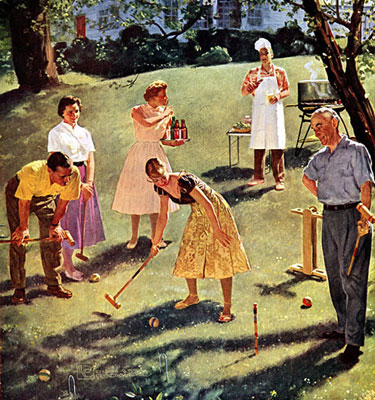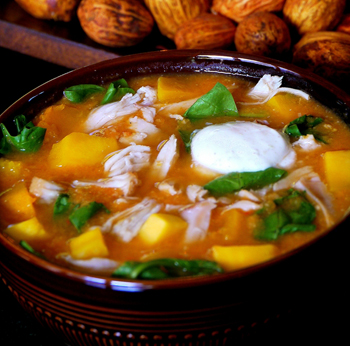 Judging by the latest rain storms and night time cold, it's still winter, at least the Southern California version. But a walk through our local farmers' market (the Wednesday Santa Monica and Sunday Pacific Palisades Farmers' Markets) and you'd think it was summertime. Just about everything you could want is in the market, with the exception of fresh corn and pluots. Tomatoes are showing up again and they're beautiful, but they're better for roasting than eating raw.
Judging by the latest rain storms and night time cold, it's still winter, at least the Southern California version. But a walk through our local farmers' market (the Wednesday Santa Monica and Sunday Pacific Palisades Farmers' Markets) and you'd think it was summertime. Just about everything you could want is in the market, with the exception of fresh corn and pluots. Tomatoes are showing up again and they're beautiful, but they're better for roasting than eating raw.
One of my favorite recipes (and one of the easiest) uses those late winter tomatoes to good advantage. Some farmers this time of year mark down their mottled and misshapen tomatoes. Eaten raw, they aren't desirable, but roasted and used with pasta or in a sauce, they're delicious.
Spring
Spring
Broiled Chicken Breasts with Fennel, Meyer Lemon, and Green Olives
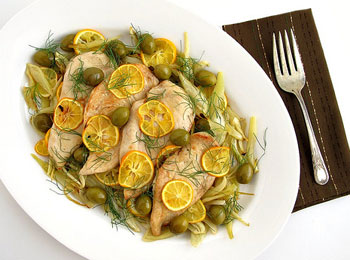 Mediterranean flavors are the ones I turn to when I'm in a cooking rut and can't figure out what to make. That's when I cook with ingredients like lemons, olives, capers, canned tomatoes, fennel, garlic, herbs and olive oil. I always have them on hand in my pantry and refrigerator for back up. It's easy to apply these flavors to give any recipe for chicken, fish and even meat a Mediterranean feel.
Mediterranean flavors are the ones I turn to when I'm in a cooking rut and can't figure out what to make. That's when I cook with ingredients like lemons, olives, capers, canned tomatoes, fennel, garlic, herbs and olive oil. I always have them on hand in my pantry and refrigerator for back up. It's easy to apply these flavors to give any recipe for chicken, fish and even meat a Mediterranean feel.
In this recipe I'm using lemon, fennel, and olives for an easy oven tray bake. But for some extra interest I'm not just using any lemons, instead I'm using Meyer lemons, which are more flavorful and sweeter than regular lemons. Thinly sliced and roasted along with the fennel, they become soft and entirely edible. Plus I use the lemon juice for a marinade. All the flavors harmonize so well together
Using chicken cutlets for this recipe makes it come together very quickly. You can also make this recipe with fish, such as halibut or cod fillets. Simply continue to roast until the fish flakes easily. If you don't have access to Meyer lemons, use regular lemons or even oranges. And don't discard the fennel fronds, use it for garnish.
Spring Steak Salad
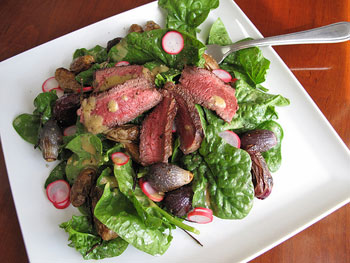 Spring brings many colorful bounties, but the best of the season comes in green. This time of year farmers' markets are brimming with tender, young vegetables. That's why my friend Caroline and I decided to take a trip to the Union Square Greenmarket this past week to see what dish we could create together.
Spring brings many colorful bounties, but the best of the season comes in green. This time of year farmers' markets are brimming with tender, young vegetables. That's why my friend Caroline and I decided to take a trip to the Union Square Greenmarket this past week to see what dish we could create together.
With all the beautiful salad greens available at the market, we naturally decided upon making a salad. After browsing all the produce to see what was the freshest and most appealing, we found some beautiful spinach for our base. We also gathered baby fingerling potatoes, baby red onions, and radishes. Caroline had the perfect idea, to flash pickle the radishes. And for a lean protein, I suggested a steak, which we picked up at the nearby Whole Foods Market. Once we had all our ingredients, we were ready to cook—and eat.
What we achieved was a colorful and healthy salad with a combination of earthy vegetables that encapsulated the flavors of spring.
Spring Feast
"Just a little sheep dip. Panacea for all stomach ailments." Mae West
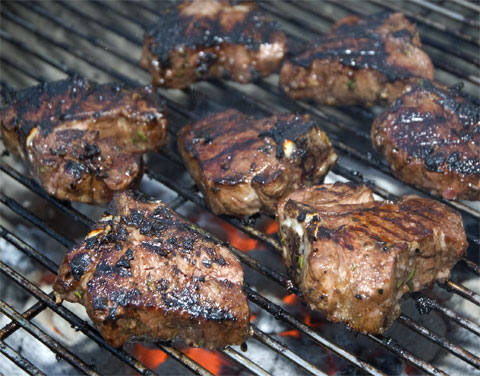 If you say you don't like lamb, you probably really mean you don't like the preparation of lamb you were served. If you have never savored the rich, tender, beefy (never gamey) flavor of a lamb loin chop, you are missing what I consider to be the best nugget of red meat in the world. Period. Really. No cow.
If you say you don't like lamb, you probably really mean you don't like the preparation of lamb you were served. If you have never savored the rich, tender, beefy (never gamey) flavor of a lamb loin chop, you are missing what I consider to be the best nugget of red meat in the world. Period. Really. No cow.
Loin chops are the porterhouse steaks of the lamb, with a T-bone separating the strip steak on one side and the filet mignon on the other. But they are a lot smaller than beef porterhouses. The best, cut 1.5 to 2" thick, are no bigger than a child's fist.
Lamb is a traditional spring dish, and this recipe uses an extremely quick and easy marinade and cooking technique. The marinade, I call it my Sheep Dip, is great on all cuts of lamb including rack, leg, and kabobs. If you don't think you like lamb, try this and you may swear off beef for life. The output is amazingly flavorful and tender and juicy and succulent and...
In Abundance
 I love this time of year. So many good things are available at the market and in such abundance. I often become distracted with all the choices, making it difficult not to come home with more groceries than I need. I then proceed to have a freak out while trying to use it all up.
I love this time of year. So many good things are available at the market and in such abundance. I often become distracted with all the choices, making it difficult not to come home with more groceries than I need. I then proceed to have a freak out while trying to use it all up.
I definitely overbought on strawberries last week and needed a plan. Luckily I came across these Strawberry Yogurt Muffins over at Culinary Wannabe. They are the perfect breakfast muffin; healthy, low-cal, filling and very yummy. I individually wrapped each one and froze them together in a Ziploc bag for a quick breakfast.
This muffin uses part whole wheat flour which I prefer when it comes to breakfast noshing. However, these do not taste healthy at all. In fact, they taste a bit sinful. They are awesome.
If you have some strawberries to use up, I would consider making these, you'll love them.
More Articles ...
Welcome to the new One for the Table ...
Our Home Page will be different each time you arrive.
We're sure you'll find something to pique your interest...

